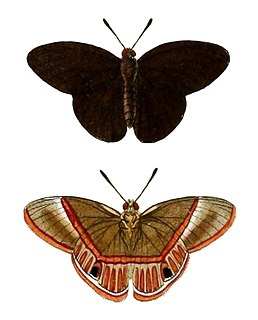
The owl butterflies, the genus Caligo, are known for their huge eyespots, which resemble owls' eyes. They are found in the rainforests and secondary forests of Mexico, Central, and South America.

Euploea eunice, commonly called blue-banded king crow, is a butterfly found in the Indomalayan realm that belongs to the crows and tigers, that is, the Danaid group of the brush-footed butterflies family.

Cethosia biblis, the red lacewing, is a species of heliconiine butterfly belonging to the family Nymphalidae.

Ithomiini is a butterfly tribe in the nymphalid subfamily Danainae. Some authors consider the group to be a subfamily (Ithomiinae). These butterflies are exclusively Neotropical, found in humid forests from sea level to 3000 m, from Mexico to Argentina. There are around 370 species in some 40–45 genera.

Limenitis reducta, the southern white admiral, is a butterfly of the family Nymphalidae.

Voltinia is a genus of metalmark butterflies. The genus was erected by Hans Ferdinand Emil Julius Stichel in 1910. Even including Eucorna, which some authors consider a distinct genus, it contains only a few species:

Narope is a genus of Neotropical butterflies in family Nymphalidae, and includes species that present inconspicuously marking patterns on the wings. The genus includes 16 species.

Emesis is a Neotropical genus of butterflies.

Opsiphanes cassina, the split-banded owlet, is a species of butterfly belonging to the family Nymphalidae.

Eueides isabella, the Isabella's longwing or Isabella's heliconian, is a species of nymphalid butterfly, belonging to the Heliconiinae subfamily.

Catoblepia xanthus is a butterfly of the family Nymphalidae. It is found in northern South America.

Adelotypa is a genus of butterflies in the family Riodinidae. They are found in South America.

Brassolis sophorae is a species of large butterfly in the family Nymphalidae. It is found in South America.

Caligo oileus, the Oileus giant owl, is a butterfly of the family Nymphalidae.

Hermathena candidata is a species of butterfly in genus Hermathena of the family Riodinidae. It is found from Costa Rica to Colombia, the Guianas and Bolivia east of Andes.

Heliconius aoede, the Aoede longwing, is a species of butterfly of the family Nymphalidae. It was described by Jacob Hübner in 1813. It is found in the Amazon basin. The habitat consists of deep forests.

Caligo teucer, the Teucer owl butterfly is a butterfly of the family Nymphalidae. It was described by Carl Linnaeus his 1758 10th edition of Systema Naturae. It is found from Colombia and Venezuela to Bolivia and Paraguay. The habitat consists of rainforests and cloudforests at altitudes ranging from 400 to 1,400 meters.

Euselasia is a genus in the butterfly family Riodinidae present only in the Neotropical ecozone.
Tomares romanovi, or Romanoff's hairstreak, is a butterfly of the family Lycaenidae. It is found in Armenia, Azerbaijan, Georgia, eastern Turkey, northern Iran, and Kopet Dagh mountains.

Melanis pixe, the red-bordered pixie, is a species in the butterfly family Riodinidae. It was described by Jean Baptiste Boisduval in 1836.


















